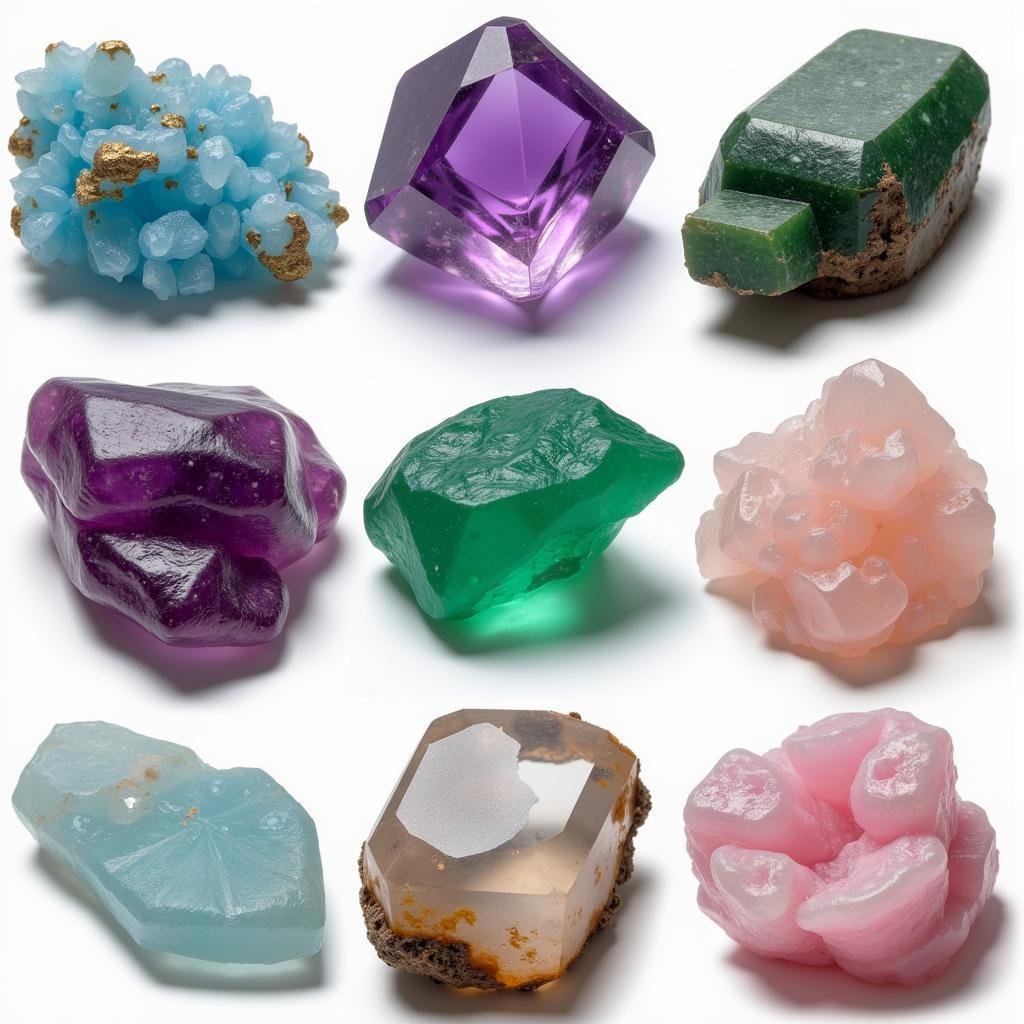Crystal, in its purest form, is colorless and transparent. However, the world of crystals is far more vibrant than that! Many factors can influence a crystal’s perceived color, creating a dazzling array of hues. From trace mineral impurities to structural imperfections, the color of a crystal tells a unique story of its formation and composition. Let’s delve into the fascinating world of crystal color and explore what makes each gem unique. what color is crystal explains the various factors contributing to crystal coloration.
Understanding Crystal Color
The absence of color in pure crystal, like quartz, is due to its perfectly ordered atomic structure. Light passes through without being absorbed, resulting in transparency. However, even slight variations in this structure can drastically alter the way light interacts with the crystal. This is where the magic of color begins.
Trace Minerals and Impurities
One of the primary reasons for color in crystals is the presence of trace minerals or impurities within the crystal lattice. These foreign elements can absorb certain wavelengths of light, while reflecting or transmitting others. For example, amethyst, a variety of quartz, owes its stunning purple hue to traces of iron. Similarly, the presence of chromium can create the vivid green of emerald. Even minute amounts of these trace elements can profoundly affect a crystal’s appearance.
 Trace Minerals Influencing Crystal Color
Trace Minerals Influencing Crystal Color
Structural Imperfections
Another fascinating aspect of crystal color is the role of structural imperfections. These imperfections, also known as defects, can disrupt the regular arrangement of atoms within the crystal lattice. This disruption can create color centers, which absorb specific wavelengths of light, giving the crystal a distinctive color. Smoky quartz, for instance, gains its smoky brown or black color from radiation-induced structural defects.
How Light Interacts with Crystals
The color we perceive in a crystal is essentially the light that is not absorbed. When white light, which contains all the colors of the spectrum, encounters a crystal, certain wavelengths may be absorbed while others are reflected or transmitted. The reflected or transmitted wavelengths are what we see as the crystal’s color. For a more detailed explanation of this process, check out how do crystals get their color.
What Color is Crystal Meth?
While we primarily discuss naturally occurring crystals, it’s important to address the query “what color is crystal meth?” as it’s a common search term related to “crystal”. Crystal methamphetamine is a dangerous, illegal drug that can appear in various forms and colors, from clear to white, brown, or even pink. It’s crucial to remember this context and differentiate it from the discussion of natural crystals. Learn more about the dangers of crystal meth at what color is crystal meth.
 Crystals in Various Colors
Crystals in Various Colors
Exploring the Spectrum: What Colors Are Crystals?
Crystals come in a vast array of colors, encompassing almost every hue imaginable. From the deep reds of ruby to the calming blues of aquamarine, the possibilities are endless. what colors are crystals offers a deeper look into the spectrum of crystal colors.
Creating Color in Crystals: How to Color Crystals
Interestingly, the color of some crystals can be artificially altered or enhanced through various treatments. These treatments can range from heating to irradiation and even dyeing. While some treatments are considered acceptable in the gemstone industry, others are not. Learn more about these processes at how to color crystals.
“The interaction of light and the crystal’s internal structure creates a symphony of colors,” explains Dr. Gemma Stone, a renowned gemologist. “Each crystal, with its unique composition and history, reflects a story of Earth’s powerful forces.”
Another expert, Professor Crystal Clear, adds, “The beauty of crystals lies not only in their aesthetic appeal but also in the scientific marvel they represent.”
Conclusion
The color of a crystal is far more than just a visual attribute; it’s a fingerprint of its unique journey through time and geological processes. From trace mineral inclusions to structural defects, a variety of factors contribute to the vibrant hues that captivate us. Understanding what contributes to the color of crystal allows us to appreciate these natural wonders even more deeply.
FAQ
- What is the natural color of pure crystal? Pure crystal is colorless and transparent.
- Why are some crystals colored? Trace minerals, structural defects, and the way light interacts with the crystal’s structure are the main reasons.
- Can the color of crystals be altered? Yes, some crystals can have their color artificially altered or enhanced through various treatments.
- What is the most common color of quartz? Clear or colorless is the most common color for pure quartz.
- What mineral gives amethyst its purple color? Iron is the trace mineral responsible for the purple color of amethyst.
- What causes the smoky color in smoky quartz? Radiation-induced structural defects cause the smoky color.
- Where can I find more information about different crystal colors? You can explore more about the diverse world of crystal colors by researching specific crystal types online and in gemology books.
Need Help Choosing the Perfect Colors for Your Space?
Contact Color Box Hanoi for personalized color consultations and expert advice. Call us at 0373298888, email us at [email protected], or visit our showroom at 86 Cau Giay, Hanoi. We have a 24/7 customer service team ready to assist you.
For more helpful information, check out these articles on our website:
- Crystal Color Meanings
- The Science of Crystal Formation
- How to Care for Your Crystals
We are eager to help you transform your living space with the magic of color!
